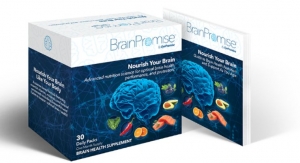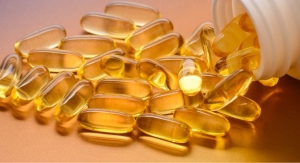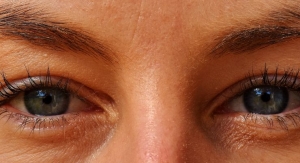I can see clearly now, the rain is gone,
I can see all obstacles in my way
Gone are the dark clouds that had me blind
It's gonna be a bright (bright), bright (bright)
Sun-Shiny day.-Johnny Nash
Unfortunately for millions of Baby Boomers impaired by a vision condition, this popular Johnny Nash song doesn't ring true. But let's not forget about the younger generations, which are also fast-becoming concerned about their eye health. They too are worried about whether or not they will be able to see clearly and enjoy the bright sun-shiny days ahead.A great majority of "graying" consumers are actively taking steps to protect visual acuity and prevent cataracts and blindness, according to Philip Gowaski, sales and marketing manager, Chrysantis, West Chicago, IL. "The Natural Marketing Institute (NMI) indicates that 75% of the general population is concerned about preventing vision problems," he said. "Nearly 10% of adults in the U.S. reported that they have some sort of vision impairment. That increases to 15% when narrowed to adults aged 45 to 64. Indeed, ocular impairment is one of the top reasons elderly people lose their independence. Furthermore, the U.S. spends more than $68 billion on direct and indirect healthcare costs related to visual impairment."
Fiona Taylor, director of marketing, InterHealth Nutraceuticals, Inc., Benicia, CA, says increased incidence of type 2 diabetes has also resulted in many more people becoming aware of eye health, especially since diabetes is a serious risk factor for blindness and other vision problems.
Even though the driving force behind the purchase of eye health products is Baby Boomers reaching the age where cataracts, glaucoma, age-related macular degeneration (AMD) and other ocular afflictions become more prevalent, it has become increasingly necessary to take measures to protect vision across all age-groups. This is particularly relevant in today's world when considering the adverse effects of UV light on the eye, as well as the use of screen-based equipment or visual display terminals (VDT) at work and leisure. These have created a market for products that can help consumers suffering from eye fatigue, or asthenopia.
Market Insights
Citing data from Health Focus International, Rob Bailey, marketing manager, Cognis Nutrition & Health, La-Grange, IL, claims eye health ranks 4th among U.S. shoppers as an important health concern; 47% of shoppers are extremely or very concerned (the top three concerns are cancer, cardiovascular disease and lack of energy).
Chrysantis' Mr. Gowaski says this is backed by strong positive clinical research, which continues to emerge. As a result, the eye health market is aggressively formulating new products to keep pace with the science, and with consumer demand. "Reaching potential consumers and educating them on the latest developments remains the key to success in this growing marketplace," he said.
According to Nutrition Business Journal's "2006 Supplement Business Report," InterHealth's Ms. Taylor said specialty formulas designed for specific conditions have been the trend in multi-vitamins, with eye health formulas being among the most notable examples.
Dietary supplements in the form of soft gels, capsules and tablets still seem to be the preferred delivery method, although experts agree consumer interest for eye health beverages and foods will gain momentum in the coming years. This will likely include powder and ready-to-drink beverages, as well as nutrition bars, effervescent products, oral strips, gummies, liquid drops, chewable formats and hard candies.
To that end, Carol Locey, senior research manager-Zeaxanthin, Kalsec, Kalamazoo, MI, expects functional foods to be a significant delivery system for eye health supplements. "I could see lutein and zeaxanthin, the macular pigments, being used in foods as part of a package of antioxidant carotenoids important for eye, skin, cardiovascular and neural health," she said. In fact, she pointed out that Kellogg's Smart Start Antioxidant cereal already mentions lutein and zeaxanthin as important carotenoids on the back panel.
Sanjaya Mariwala, managing director, OmniActive Health Technologies, Mum-bai, India, also speculated about various delivery forms. "More products in the form of interesting formulations for food and snacks are very likely to emerge and significantly expand the current size of the market," he said. "Several food companies are actively looking at lutein delivery forms with enhanced stability in their applications compared to options hitherto available in the market. Stable, water-dispersible forms with vegetarian ingredient systems, which are safe, food grade and Kosher/Halal are generating a lot of interest." Mr. Mariwala has also witnessed heightened interest in formulations of nutrients with a synergistic effect toward eye health, such as lutein and omega 3 oils, or multiple carotenoids in a complex, or lutein along with a specific combination of antioxidants.
And according to Charlene Lee, marketing director, Cyvex Nutrition, Irvine, preferable delivery forms are in the eye of the beholder-some people prefer to obtain their nutrients through food and beverage form, others just want to quickly swallow pills. Ultimately, Ms. Lee believes the industry will have to provide consumers with an array of high-quality options.
An Eye on Ingredients
New pharmaceutical drugs for the treatment of advanced eye diseases have recently made a splash in the market. However, Chrysantis' Mr. Gowaski pointed to a recent study in Ophthalmology, which concluded that these new pharmacologic therapies for retinal conditions are extremely expensive, and some yield marginal visual dividends. "The only proven therapy is the use of supplements to decrease the risk of vision loss," he said.
Lutein & Zeaxanthin.
The carotenoids lutein and zeaxanthin continue to be stars in the eye health world due to consumer recognition and the large number of studies supporting their role in preventing eye health conditions such as AMD and cataracts."There are only two dietary carotenoids in the eye, lutein and zeaxanthin, which are found at a ratio of 4 parts lutein to 1 part zeaxanthin," said Kalsec's Ms. Locey. "While zeaxanthin is often combined with lutein in research data, its importance in eye health is unique." She said it is only in the last few years that high-performance liquid chromatography (HPLC) techniques have been developed to allow re-searchers to look at the effect of zeaxanthin independently from lutein. In the macula, where the greatest exposure to light induced oxidation occurs, there is over two times as much zeaxanthin compared to lutein.
Lutein products are available in two forms, as natural lutein esters and "free" unesterified lutein. Over the years there has been some debate as to which is more effective. "Almost all supplementation studies-whether as lutein esters or free lutein-show a positive correlation with enhanced serum and tissue concentrations of lutein and zeaxanthin, and with markers of good eye health," said Omni's Mr. Mariwala. "And e-nough studies keep coming along to show that both forms of lutein in supplement form are relevant."
A recent study conducted by DSM Nutritional Products, Inc., Parsippany, NJ, suggested that night vision could be improved by supplementing with lutein and OptiSharp brand zeaxanthin. The study appeared in Ophthalmic and Physiological Optics, The Journal of the College of Optometrists. Researchers found convincing evidence to show that participants taking the combination of lutein and zeaxanthin significantly improved their ability to see in dim light. The research also suggested that the combination of lutein and OptiSharp zeaxanthin improved the image quality at the retina.
Mr. Mariwala also pointed to research showing that lutein effectively filters out UV radiation, which can potentially damage the human eye, and that lutein and zeaxanthin are effective in quenching the effect of reactive oxygen species and free radicals that could cause further damage to the sensitive tissues of the eye's retinal and macular regions.
"Lutein (along with its structural isomer zeaxanthin) are safe for human consumption even at maximum daily intake levels of 2 mg/kg body weight (i.e., around 90-150 mg per day for most adults)," said Mr. Mariwala. "This clears the way for higher dosages of lutein to be incorporated into supplements and nutritional foods over and above current levels."
Ms. Locey is particularly excited about the trend toward more complete, well-balanced eye health formulas containing higher levels of zeaxanthin, vitamins C and E, and omega 3 fatty acids. Kalsec's ZeaGold, an all-natural zeaxanthin from a whole food source, is an extract of sweet peppers (paprika) that contains not just zeaxanthin, but also all of the nutrients found in this fruit of the Capsicum annuum plant.
In other news, DSM Nutritional Products is looking at additional eye health claims related to lutein, zeaxanthin and other nutrients that can broaden the target market beyond mature individuals. "As clinical studies are completed and released, findings like these will reinforce the importance of supplemental nutrients for good eye health," said Bob Berman, senior marketing manager, New Business Development, DSM Nutritional Products, Inc.
Omega 3 Fatty Acids.
Omega 3 fatty acids have become well-known for their benefits in the areas of heart, joint, brain and mood health, but consumers may not be as familiar with the role omega 3's play in vision support. Hopefully a study published last year in the July issue of the Archives of Ophthalmology will change that. The study found that dietary omega 3 intake is inversely associated with the incidence of AMD.According to Greg Berthomieu, business development manager, Pharmline Inc., Florida, NY, regular intake of omega 3 fatty acids may also have a prophylactic effect on two other common eye diseases leading to blindness, glaucoma and maculopathia. "Glaucoma is a disease of the eye caused by increased intra-ocular pressure leading to irreversible defects in the retina. Omega 3 fatty acids have pressure reducing effects on the eye that may help prevent this disease," he said. "Maculopathia is another age-related disease of the eye and studies are showing a possible solution for prevention of this degenerative disease through the use of omega 3's."
Strong evidence also suggests that the long-chain polyunsaturated omega 3 fatty acid DHA (docosahexaenoic acid) has the potential to aid in eye health. This is because Philip Fass, executive director of marketing, for Martek Biosciences, Columbia, MD, claims DHA represents about 97% of all omega 3 fatty acids in the brain and 93% of all omega 3 fatty acids in the retina.
Furthermore, Mr. Berthomieu said research carried out at the University of Bristol, U.K., and the University of Texas both showed that having an adequate supply of DHA was important in the development of good infant eyesight.
Astaxanthin.
Another star carotenoid that seems to be receiving a lot of attention is astaxanthin, which some experts claim is one of most powerful antioxidants yet discovered. "Based on the ORAC scale for antioxidants, it has been shown to be up to 500 times more powerful than vitamin E, 10 times more potent than beta-carotene and five times more potent than lutein," said Sid Hulse, vice president, Sales & Markeing, Valensa, Eustis, FL. "This high level of antioxidant activity means it is in a much better position to address age-onset conditions related to oxidative stress, such as AMD. Astaxanthin's molecular composition makes it hydrophilic and lipophilic at the same time, which allows it to function at the important lipid/aqueous interfaces."Unlike the carotenoids lutein and zeaxanthin, which are normally found in the eye, astaxanthin is not. Cyanotech Corp.'s (Kailua-Kona, HI) Natural Astaxanthin: King of the Carotenoids, authored by Bob Capelli, vice president of sales and marketing, and Gerald Cysewski, PhD, CEO and founder, discusses how excessive exposure to sunlight and to the highly oxygenated environment causes free radicals to be generated in the eye. Once the retina is damaged, it cannot be replaced. Therefore, antioxidants that can reach the inner eye by crossing the blood-brain and blood-retinal barriers are essential in protecting the eye against the damaging conditions. Dr. Mark Tso of the University of Illinois was the first person to prove that astaxanthin could do just that. After feeding laboratory rats astaxanthin, he tested them to find astaxanthin present in the retina. "He proved that astaxanthin could cross first the blood-brain barrier and get into the brain, and then once in the brain it could reach the retina and the macula by crossing through the blood-retinal barrier," Mr. Capelli explained. "Through an extensive series of tests, Dr. Tso went on to show that astaxanthin has many protective properties once it reaches the eyes. He found that astaxanthin possessed the ability to protect the eye from light-induced damage, photoreceptor cell damage, ganglion cell damage, neuronal damage and inflammatory damage."
As previously mentioned, older consumers have been the driving force behind the growth in the eye health market because of their age proximity to the development of eye diseases, but today's younger consumer has evolved around a computer/video culture, both at work and at home, presenting the market with a distinct opportunity based on a more immediate eye health issue-chronic eye fatigue. "I do not believe the supplement market has yet recognized the potential for eye fatigue as a viable area," said Charles De-Prince, president, Fuji Health Science, Inc., Mount Laurel, NJ. "However, a strong body of science now exists to support a new nutritional ingredient that provides relief for eye fatigue. Fuji Chemical Industry Co., Ltd. of Japan has sponsored nine human clinicals, all of which used AstaReal astaxanthin and demonstrated with significant results the beneficial effect of this ingredient in reducing the effects of eye fatigue.
"I see the use of astaxanthin for eye fatigue as a way to increase the dietary supplement market segment for eye heath in two ways," continued Mr. DePrince. "Either through a stand alone product specifically targeting eye fatigue or to enhance or differentiate current eye health products with the addition of astaxanthin to include eye fatigue."
Bilberry.
Clinical trials have demonstrated the benefits of bilberry in the management of visual disorders such as retinopathy. The bioavailable anthocyanins found in bilberry are considered to be the main contributors to its therapeutic activity. But the bilberry category has been plagued with a variety of trade issues lately, especially in relation to adulteration. Greg Ris, vice president sales, Indena USA Inc., Seattle, WA, discusses this problem in more detail. "There are some challenges this year due to the poor bilberry crop of last summer, which has resulted in higher prices for legitimate material," he said. "Not surprisingly, however, there are suppliers offering bilberry that is adulterated with different berries (e.g., elderberry) and dyes (e.g., amaranth) to keep costs down. Under basic chemical analysis (e.g., UV) this material can be approved by laboratories."Mr. Ris predicts the eye health sector to remain strong unless consumer confidence suffers due to the presence of ineffective (adulterated) and un-substantiated products littering the market.
Other Ingredients.
Zinc, required for numerous vital cell functions, is the most publicized mineral when it comes to healthy vision. "It is essential for oxidation and metabolism, which are both necessary for eye health," said InterHealth's Ms. Taylor. "Zinc concentrations are higher in the eyes than anywhere else in the body, and they are especially high in the retina. Zinc has been shown to help support healthy night vision and is also essential to the activity of dozens of enzymes, including the antioxidant enzymes involved in protecting the lens from cataracts and the macula from macular degeneration. In fact, a study published in the Archives of Ophthalmology showed that zinc could help reduce the risk of AMD by as much as 25%." But Ms. Taylor warns that the way in which zinc is formulated makes a significant difference in its efficacy.Over the years, Pycnogenol has been gaining ground in the eye health arena as a result of positive outcomes in clinical trials. Pycnogenol is a natural plant extract originating from the bark of the maritime pine that grows along the coast of southwest France and is found to contain a unique combination of procyanidins, bioflavonoids and organic acids. Natural Health Science (NHS), Hoboken, NJ, is the North American raw material supplier of Pycnogenol. "Pycnogenol has been investigated thoroughly in clinical trials for stopping the progression of a developing diabetic retinopathy," said Frank Schonlau PhD, director of scientific communication, NHS/Horphag Re-search-supplier of Pycnogenol worldwide. "This disease of retinal capillaries spilling blood causes irreversible vision loss. Retinopathy develops gradually with time in diabetics, and good glucose control is key for its prevention. With some delay, the dramatically increasing numbers of diabetic people will cause a significant increase of retinopathy cases in future."
In a German multi-center field study, 1169 diabetic retinopathy patients were treated with Pycnogenol. All of these patients showed retinal degeneration and 49% had previously received other medication. The outcome revealed that Pycnogenol not only successfully stopped further deterioration of visual acuity, but it also improved eyesight to some extent. "A current ongoing clinical trial with Pycnogenol will further substantiate its virtues for preventing the onset of retinopathy in diabetic subjects," said Dr. Schonlau.
Ms. Lee from Cyvex indicates that phytonutrients also aid in the sustenance of ocular health. "For example, in vitro studies have shown that the isothiocyanate sulforaphane, found abundantly in broccoli, is useful for vision health," she said. "In one study, human adult retinal pigment epithelial cells were treated with sulfora-phane. Researchers found that the broccoli compound protected against toxicity of oxidant stressors for at least three days following termination of sulforaphane treatment."
A Look at Major Research Initiatives
According to the National Eye Institute (NEI), AMD is a leading cause of vision loss in Americans 60 years of age and older. "Nearly two million Americans experience vision loss from advanced AMD, and another seven million with AMD are at substantial risk for vision loss," explained Paul Sieving, MD, PhD, director of NEI. NEI reports that these statistics will double in numbers by 2030 because of the increasing longevity of the U.S. population.
AMD is a disease associated with aging that affects the macula and gradually destroys sharp, central vision. AMD occurs in two forms: wet and dry. Wet AMD, also known as ad-vanced AMD, is caused by the abnormal growth of blood vessels under the macula, leading to rapid loss of central vision. Dry AMD, the more common form, occurs when the light-sensitive cells in the macula slowly break down, gradually blurring central vision in the affected eye.
Results from a landmark study-the Age-Related Eye Disease Study (AREDS)-were released six years ago and found that high-dose antioxidant vitamins and minerals (vitamins C and E, beta-carotene, zinc and copper) taken by mouth reduced the risk of progression to advanced AMD by 25%, and the risk of moderate vision loss by 19%. NEI now recommends that people at high risk for developing ad-vanced AMD consider taking the AREDS formulation, though it also reminds consumers that the AREDS formulation is not a cure. In addition, the AREDS formulation will not re-store vision already lost from the disease. However, it may delay the onset of advanced AMD and may help people at high risk for developing advanced AMD keep their vision.
NEI is currently working on refining the results of the original study by conducting a new multi-center randomized trial, AREDS2, which will add dietary xanthophylls (lutein/zeaxanthin) and omega 3 LCPUFAs (DHA and EPA) to the study formulation. NEI will conduct this more precisely targeted study to see if the new combinations of nutrients can reduce advanced AMD progression even further. This objective will be accomplished by collecting and assessing data on approximately 4000 AREDS2 participants aged 50 to 85 years, who at the time of enrollment have either: 1) bilateral large drusen or 2) large drusen in one eye and advanced AMD in the fellow eye. AREDS2 started recruiting participants in October 2006 and hopes to complete recruitment by the end of this year. Once recruiting is finished, the study will be conducted over a period of five years.
DSM Nutritional Products is supporting the large-scale AREDS2 Phase III trial by providing the lutein, zeaxanthin and omega 3 fatty acid ingredients.
"It is important to note that NEI selected a 5:1 ratio of lutein:zeaxanthin for the AREDS2 study based on a large number of observational studies," said Mr. Berman. "Most studies, such as AREDS2, include supplemental zeaxanthin, not just the slight amount of zeaxanthin that occurs naturally in lutein." Unfortunately, he says, there are still many eye-related nutritional products or multivitamins making eye health claims that only contain lutein and not zeaxanthin, or claim zeaxanthin based on the slight amount of zeaxanthin in lutein. "Both kinds of products should have supplemental zeaxanthin in addition to lutein," he said.
After careful review of available studies, it's apparent that NEI be-lieves enough in the potential of lutein, zeaxanthin and omega 3 fatty acids for eye health. At Nutracon 2007, Joseph Betz, PhD, director, Dietary Supplements Methods and Reference Materials Program of the NIH made the following statement: "You don't go into a Phase III clinical trial unless you expect it to be successful."
In other research news, an open case control study of a supplement containing Taurine, Omega 3 fatty acids, Zinc, Antioxidant and Lutein-known as the TOZAL study-found that over 76% of subjects receiving the nutritional supplement demonstrated stabilization or improvement of Best Corrected Visual Acuity (BCVA) over a six-month period. Dr. Ed Paul, an op-tometrist based in Wilmington, NC, developed the formula for the nutritional supplement, Vision Factor, used in the study.
The TOZAL study enrolled 37 mixed gender patients, with a mean age of 76 years, at five independent study sites. Results were compared to a placebo cohort constructed from the literature that was matched for inclusion and exclusion criteria. Subjects gained an average of 0.0541 logMAR, or one-half of a line of visual acuity over the six-month period. The full details of the study were published in the February 2007 issue of BMC Ophthalmology.
A recent pilot study sponsored by Macular Health, LLC, Birmingham, AL, evaluated patients with dry AMD and found that all patients improved in visual acuity and retinal function with the use of the Macular Health supplement formula. Multifocal electroretinogram (MERG) recordings were used at baseline and after a two-month follow-up of 10 patients' eyes without nutritional supplements compared to 10 patients' eyes placed on daily high-dose beta-carotene, vitamins C and E, zinc, copper, lutein and zeaxanthin. Visual acuity testing measured the effects of the supplement on visual function in both groups. Macular function improvement was seen in all patients placed on nutritional supplements. The study utilized a patented formula created by Macular Health, which combines 10,000 IU vitamin A (beta-carotene), 125 mg vitamin C, 100 IU vitamin E, 55 mg zinc, 2 mg copper, 10 mg lutein and 440 mg zeaxanthin.
A View of the Future
The eye health market has an exciting future as new studies and products continue to flood the market. "The future for this market has enormous potential, especially consideringthe demographics," said Cyvex's Ms. Lee. "Baby Boomers and Generation X (those in their 30s and early 40s) are prime candidates for wanting to preserve their vision. In addition, it is imperative that the research of caro-tenoids and other antioxidants in vision preservation be sustained. Long-term and large-population studies will most certainly help, especially in instilling confidence in and hence long-term use by consumers as they age."
From a product standpoint, Valensa's Mr. Hulse said, we're not done yet. "While there are some excellent products currently on the market, we should continue our pursuit of more efficacious compounds and better science to make our offerings in this market even more desirable to consumers."
But the industry is still at risk of losing consumer confidence if certain issues are not addressed. This concern is underlined by the practice of using ingredients in such low amounts in formulas that the consumption of these products won't have any significant impact on eye health. This makes it imperative that formulas include therapeutic doses-reflecting the dosages that research has found to be effective. "Anything less is worthless and a waste of money for the consumer," said Ms. Lee.
Mr. Hulse also points out that most of the successful studies on compounds promoting eye health have been conducted using natural materials. For carotenoids, however, he claims inferior synthetic versions are available that are of questionable use and are often of no physiological benefit. "Manufacturers of eye health products should be wary of these synthetic compounds," he warned.
Despite these issues and challenges, the future looks bright for the eye health market. "With the pharmaceutical industry uncovering few if any actual cures for various eye ailments using conventional drugs, prevention through nutrition will remain the focal point of interest for some time to come," said Chrysantis' Mr. Gowaski.



























